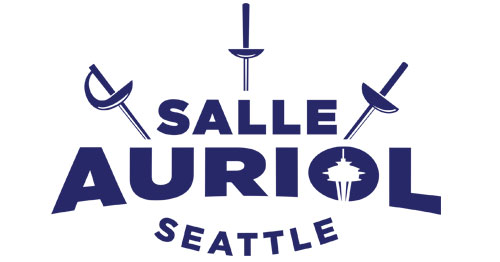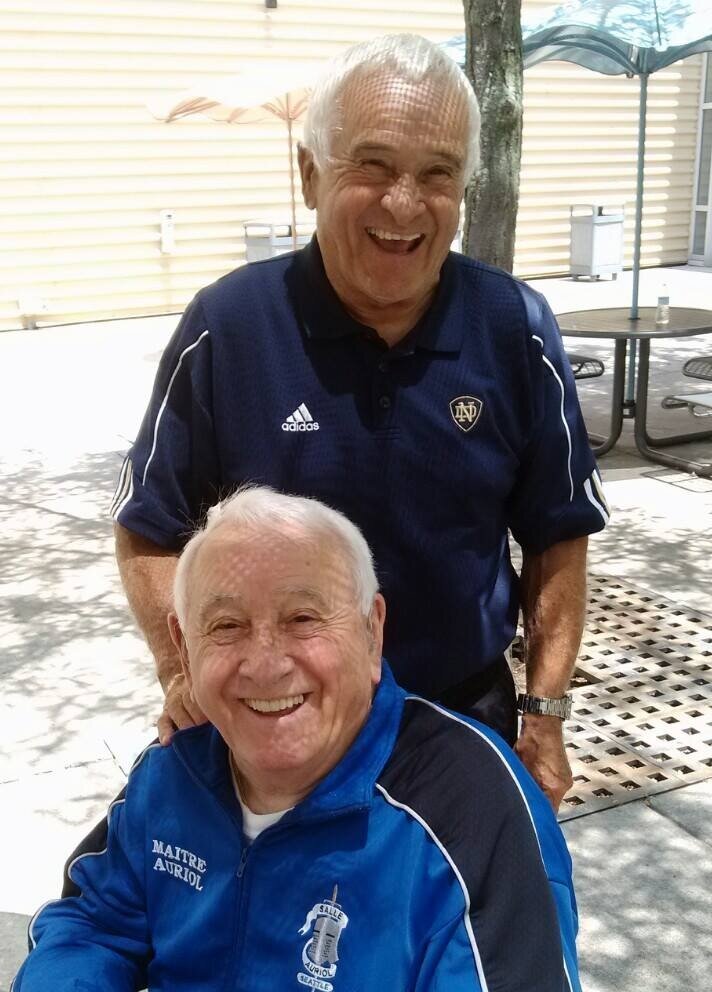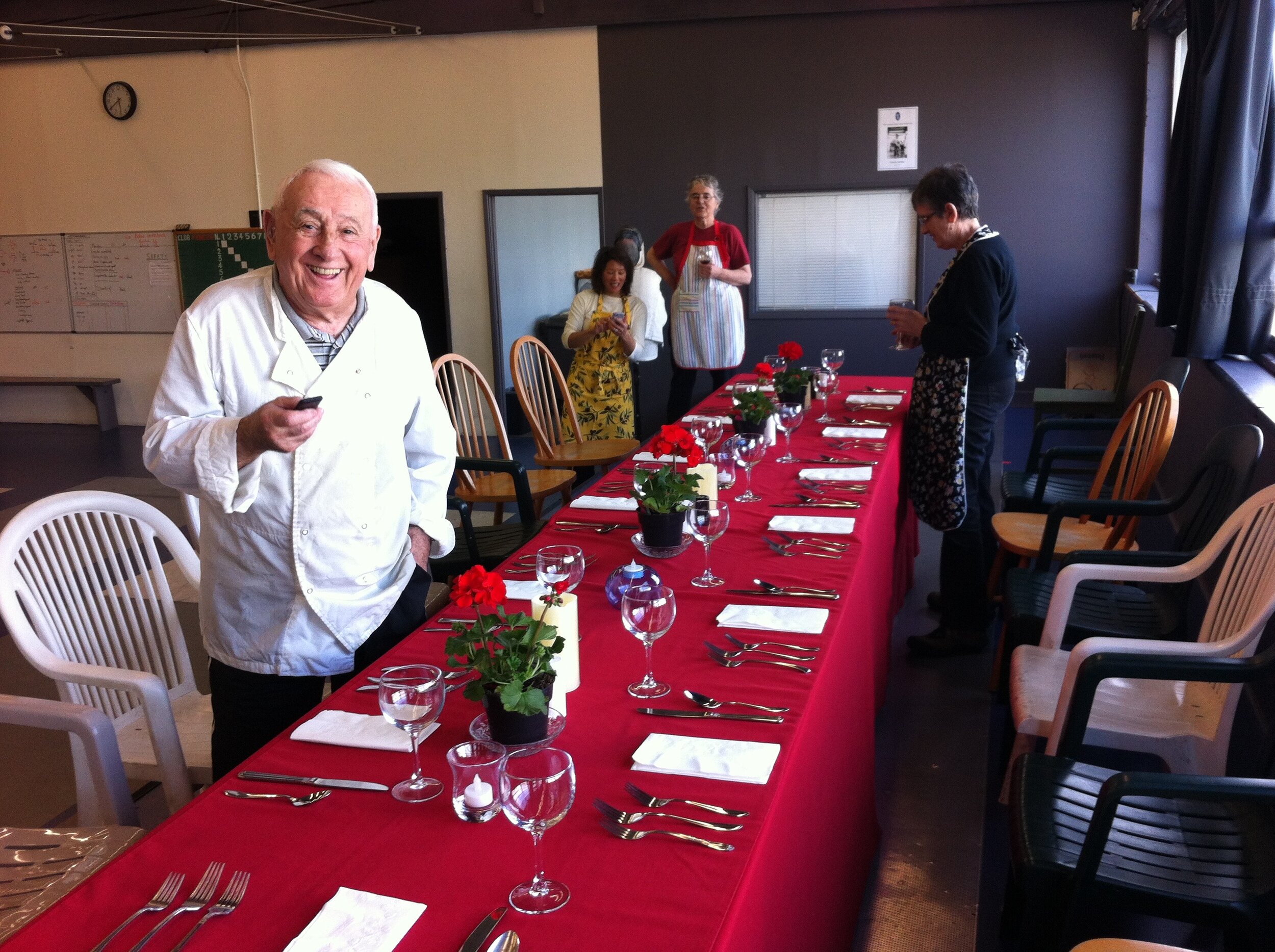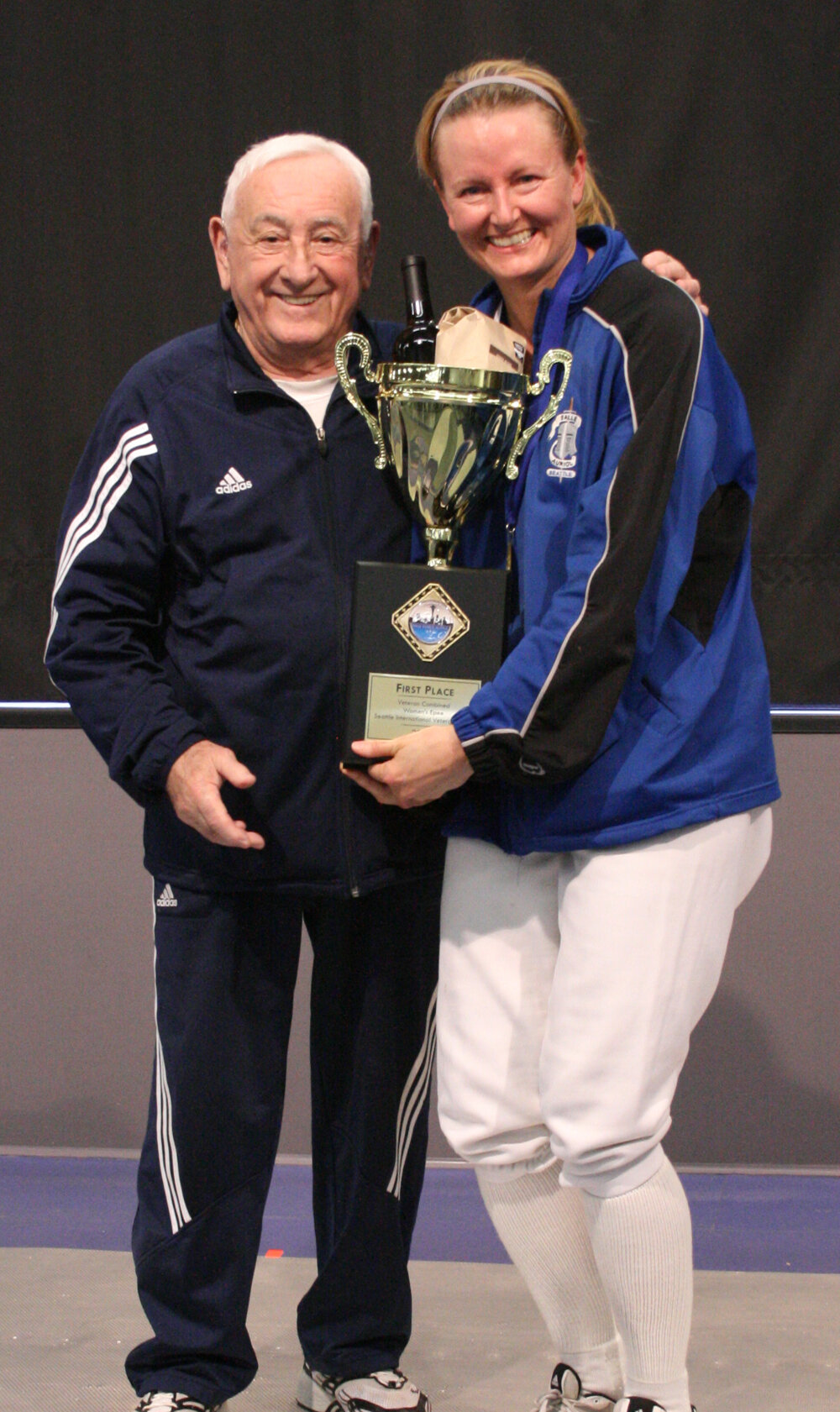Tuesday through Thursday, Maître Leon Auriol is at the club wearing his leather instructor's jacket. His students trickle in while he gives a lesson, put their names on the board, and warm up with each other. The start of Leon's lesson always demands great concentration from his student, yet slowly and imperceptibly a rhythm unfolds while his student goes through the scales of parries and ripostes. Soon the pupil gracefully flows in a current of thrusts, coupés, straight feints, circular deceives, with counter time actions followed by binds. At the lesson's end, Maître Auriol takes off his mask and shakes hands with his student.
The Early Years
Leon Auriol was born in Toulouse, July 10, 1927. The oldest of seven children, in an area wracked first by a depression and then by German occupation, Leon quit school in 1941 to help support his family.
As an outlet for his physical energy, Leon turned to sports. He threw himself into the team sports of rugby and basketball, and diligently practiced the individual combatant sport of judo. A knee injury forced him to give up rugby, so at a friend's urging Leon decided to try fencing at the Toulouse Athletic Club in 1948.
Leon Auriol's First Masters
Under Maître Maret, Leon made the transition from team to individual sport, giving up basketball and keeping only judo as a second activity.
Leon kept at his new sport and by 1952 Maître Maret allowed him to teach the beginners. Still Leon found the time to marry in 1953 and later fathered two children. In 1955, Leon earned the title of "prévot d'armes" and discovered that he actually enjoyed teaching. In the same year Leon Auriol won the gold medal in a sabre competition at Graz, Austria, beating out 42 tough competitors, many from Hungary. This was the year that Leon quit judo, after attaining his black belt, to keep his back out of pain. But he kept fencing.
In 1957 Maître Clery became a formative influence on Leon Auriol. Commandant Clery had retired from the army and took up his place as Maître Clery in Toulouse fencing. A veteran of the Second World War, Indo-China and Algeria, Maître Clery had also been a Three Weapons Masters National Champion. Wounded at Normandy in 1944, Maître Clery lost two fingers and the use of his right hand. After a year long recovery, Maître Clery came back to fencing as a left hander and remained for years a national contender and unbeatable locally. Leon firmly believes that Maître Clery was the last of a vanished elite of fencing masters who not only were elegant fencers and precise teachers, but were also spectacular and victorious competitors.
The Academy of Arms
Paris and the Academie d'Armes beckoned Leon in 1960. On a grant from the National Institute of Sport, Prévot Auriol worked eight hours a day, five days a week for two years to become a fencing master. It was a regime of foil the first year, followed by epée and sabre the second. Another left hander impressed Leon, the Corsican Maître Battesti, who could hold a coin against a wall with his foil point, release it and catch it with a prime cut over.
A would-be fencing master in France has to face a tough panel of experts who are very interested in if the candidate can fence all three weapons "properly." Having made it this far Leon had to show he could take lessons and then give lessons -- all the while keeping technique paramount, knowing the F.I.E. rules by heart and having a proper respect and knowledge for the history of fencing. Having passed this inquisition, Leon Auriol now could be called a Maître.
1963: The Year of Change
1963 marked a milestone in Maître Auriol's life. This was the year of divorce and the decision to move to America. An ad in a French fencing magazine caught Leon's attention: Maître Poujardieu, a modern pentathlon coach in San Antonio, had advertised for an epée coach. Leon's was the fourth reply, but the position was to be filled by Maître Nevot. However, by November Leon was informed that there was a need for an epee coach in Seattle to bring up pentathlete Bob Miller's weak fencing game. Leon looked up Seattle in a map and his first thoughts were, "Oh my God!" Seattle seemed so very far away.
Leon Auriol Sails to America
Soon Leon was on a French ocean liner heading for New York. He started learning English by watching ship board movies and conversing with two French speaking American ladies-one from Abilene, Texas and the other from South Carolina. Despite this intense coaching, Leon found himself unable to understand the New York customs officers. Leon's first thought in the United States was that he could never understand Americans. Leon sadly looked around the pier terminal and tried to make sense of the strange cacophony; it was then that Leon realized that he was not discouraged, rather he knew that he had to go to Seattle.
He shared a ride with a Canadian in a station wagon full of German furniture. Leaving December 19, they drove through snow to Chicago and finally reached a rainy Seattle by December 23. Seeing the Space Needle at night, lit up, along with the environs of an expanding Seattle, Leon was buoyed by optimism and instantly and firmly believed he would soon have 100 students. This was to prove incorrect.
After spending Christmas in Vancouver, B.C. Leon's friend dropped him off at the Seattle YMCA. Leon called Bob Miller, bought a French-English dictionary and started translating the technical fencing terms.
Making it in Seattle
Not having a green card, Leon taught under the table, with fees collected by his housemate Dale Griffith. Leon's old time students still like to tell stories of how Dale and Leon were forced by poverty to poach Green Lake ducks. One version ends with the unfortunate aquatic fowl being roasted on a spit supplied by a broken foil blade. While these stories are untrue, they do underscore a particularly rough period that Leon went through. But he continued to coach Bob Miller at Lakeside High School and around Green Lake.
Undismayed by Bob Miller breaking a leg and not going to the 1964 Olympics in Tokyo, Leon threw himself into teaching. Seattle fencing had definitely been different than what we know today. Collegial with roots in theatrical fencing and often meeting in art schools, the mid-sixties Seattle fencing community did not fully understand Leon's intense drive for technical and competitive excellence. A decade earlier, Master Jack Nottingham had tried, with no discernible success, to jump start Seattle fencing. But at the point of exasperation that had made Nottingham abandon Seattle, Leon was determined to stay, to be more persistent, and to concentrate more on his students.
The Journey Years
Soon word spread of Leon Auriol, and he was getting calls from Canadians in Vancouver and Colleen Olney in Portland. Thus began the career of a fencing master who taught in two countries and two states. Leon was to wear out five cars from 1965 to 1977. In 1965 Leon started coaching Peter Bakony, later to become National Canadian Epee Champion and a member of the 1968 Canadian Olympics Team. On weekends Leon would teach in Victoria and other parts of British Columbia, on Monday he would go to Portland, on the way back the next day he would teach at the University of Puget Sound. Then later in the week he would give classes at Bellevue Community College, Seattle University and the University of Washington. Despite this intense schedule Leon miraculously found time to meet his future wife, Sandy, at a Seattle German Club dance in 1966.
The Auriol Brothers in Portland
Leon was teaching fencing on a regular basis in Portland in 1967, two years later Rocky Beach got the idea to start Salle Auriol in Portland. Salle Auriol's well known patch design was Leon's. Notable students from the early Salle Auriol Portland years were Robert and Michael Marx. 1968 saw Leon as a team coach in Mexico. In 1971 Leon sponsored his brother Yves' immigration from France, the following year Yves moved down to Portland. In 1972 both Auriol brothers were coaching in Portland and establishing Salle Auriol Portland's reputation for elite fencing first in the Northwest, then throughout the United States.
The pace did not let up: during 1973 and 1974 Salle Auriol Seattle met downtown in its own facility. In 1974 Leon was coach for the Canadian Team in Grenoble. The next year saw Leon as a coach at the World Championships in Mexico City, where he saw his Junior squad member, Tim Glass, win the Under 20 Bronze in epée. One of only a handful of international medals the U.S. has accrued in this century.
A Change
In 1977 Leon and his wife took a career detour and opened a restaurant in Redmond. With the same dedication that had made him a chemist and fencing master, Leon took cooking lessons from local French chefs. Despite the excellent cuisine, his restaurant was handicapped by poor location. Leon and Sandy (a music teacher during the day) worked day and night to make it a success, but in 1980 they threw in the towel. Today Leon still cooks for family and friends. In the days of small club membership, members used to look forward to the annual Salle Auriol dinner at Leon and Sandy's beautiful and cozy A-frame in the Redmond countryside.
Seattle Fencing in the 80's
1980 saw Leon coaching in Victoria on a three-year Sports Ministry grant. From 1983 till 1985 Maître Auriol taught at the Silver Stein Fencing Club. By now Seattle fencing had gone through its sea change. Portland's national success was something the Northwest could both share in and envy. An enthusiatic new generation of fencers had sprung up, looking for a winning competitive edge, but they were not interested in systematic study. The careful layers of technique that Maître Auriol taught seemed slow and expensive to acquire in comparison to nightly collective brainstorming.
The Salle Finds a New Home
The mid-80s saw the club's shift from Seattle to the east side. Leon's core of students started meeting with him at the Safeway Fencing Club in 1986 in Bellevue. Shortly afterwards, Leon began teaching young fencers at the Westminster Chapel in Bellevue.
In 1990 Salle Auriol moved briefly to the Westminster Chapel gym and then settled at Tillicum Middle School; however, the uncertainties of the school calendar coupled with evening time limitations led the club towards finding a dedicated facility. In the summer of 1992, Pat Muir's assistance in making a site on Dexter Avenue available combined with hard work by a small group of Leon's students helped transform an electronics shop into a traditional salle d'armes.
The club was so well received that it soon outgrew its space, and within two years moved to a larger facility, an old print shop on top of the Trick and Murray building on Westlake and Thomas. Again Leon's students worked hard, again laying down a floor and applying gallons of paint to floor and walls. After several years it outgrew it's space again and expanded at that location. In 2005 Salle Auriol moved to 8th and Harrison.
Salle Auriol moved to our current location in Interbay in 2014. Leon passed away in 2015, but he is remembered fondly, and many of his students continue to have success in fencing.
Philosophy
Maître Leon Auriol's fencing philosophy and pedagogy is simple enough: practice constantly, be consistent in taking instruction, spar with a purpose and discipline, compete at the tougher national levels, and never forget that an opponent is always dangerous and must be respected. Leon is an instructor who believes that a fencer who works hard and has self faith can always succeed. Maître Auriol and his salle look forward to continually demonstrating these truths.








